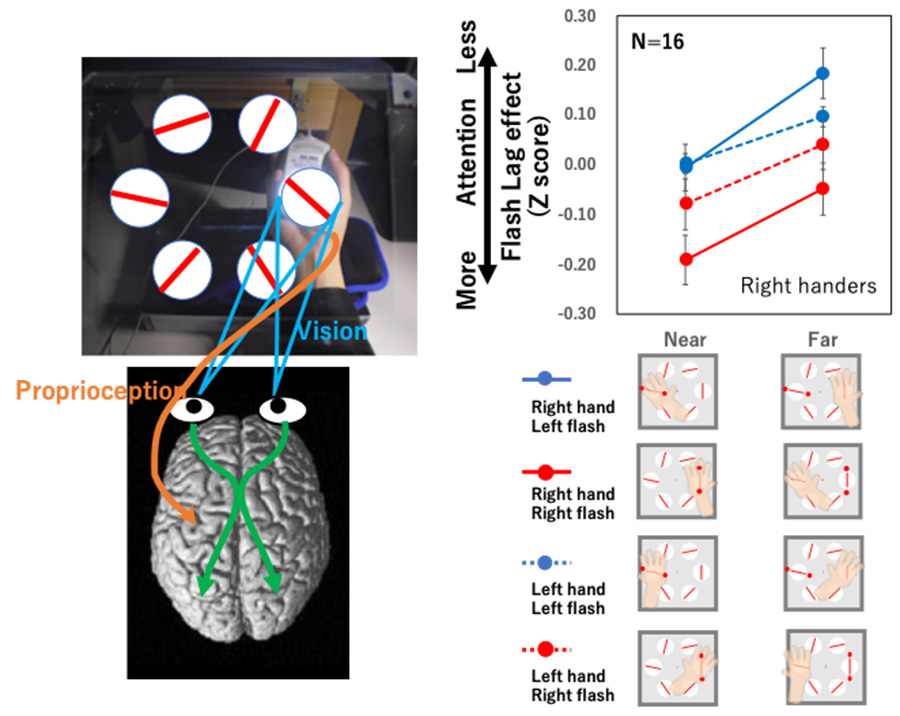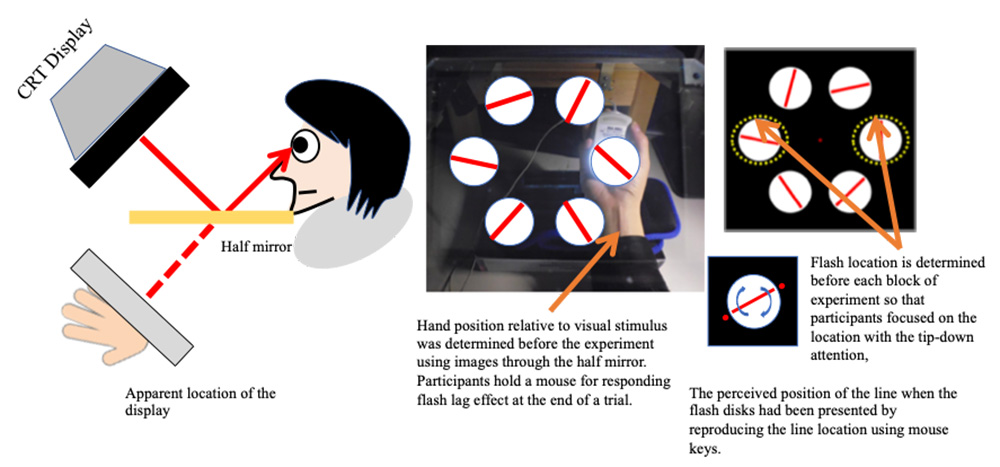Visual processing is facilitated by spaces near the hand, which is referred to as hand proximity attention. A team at Tohoku University has been studying this mechanism to isolate hand-related effects from top-down attention; proprioceptive information from visual information; and the influence of response action. They used a visual phenomenon called the flash-lag effect (FLE) as an index of attentional modulation. It was faster and more accurate to identify the visual stimuli projected with a mirror onto the location of the palm of the hand than away from it, even when the hand was invisible under the mirror. This showed that the proprioceptive information of a hand contributed to hand proximity attention, regardless of whether the visual system was activated.
Project lead Satoshi Shioiri explained that "since top-down attention was fixed at a location, we concluded that there is a process to facilitate vision around a hand independent from top-down attention." Differences between left handers and right handers, which can help understand handedness variation in the future, were also observed.

In our psychophysical experiment an observer watched visual stimuli through a half mirror. To isolate hand location information through proprioception from vision, we made the hand invisible to the observer. This left the proprioceptive signals only for an observer to know the hand's location. Hand action was excluded by using the FLE. The FLE is a phenomenon that occurs when a flash aligned with a moving object is perceived to lag behind that object, and attention reduces the amount of the FLE. We measured and compared the FLE when a stimulus was at the hand location and when it was at the other side of the display. Smaller FLE was expected with a hand nearby because attention is known to reduce FLE.
After an observer pressed a key to start a trial, the bars inside 6 discs started rotating for 5400 ms, during which a flash appeared at a random time. That was a signal for the observer to remember the rotating location of the bar and reproduced it after the trial ended. EEGs were measured during the trial to analyze the frequencies that correspond to frequencies of disc flickers and the attention effect was estimated at each disc location.

The FLE with a hand near (Near condition) was smaller than that with a hand far (Far condition) for both hands, and when the flash was presented at both the left and right visual fields for right handers (Fig. 3 right). The results reveal that the hand-proximity attention uses proprioceptive information of hand location and worked independently from the top-down attention.
When we tested left handers, the results were different. The results suggest that hand proximity attention, if present, is weaker in left handers. The results of EEG measurements are also different between left and right handers. Clear effect of top down attention and little effect of hand proximity attention was found for right handers whereas little effect of top down attention and significant effect of hand proximity attention was found for left handers. These findings suggest that the process of hand proximity attention for left-handers differs from that for right handers and they are possibly important for understanding the cause of handedness variation.

- Publication Details:
Title: Visual attention around a hand location localized by proprioceptive information
Authors: Satoshi Shioiri, Takumi Sasada and Ryota Nishikawa
Journal: Cerebral Cortex Communication
DOI: https://doi.org/10.1093/texcom/tgac005
Contact:
Satoshi Shioiri
Research Institute of Electrical Communication, Tohoku University, Japan
Email: shioiri riec.tohoku.ac.jp
riec.tohoku.ac.jp
Website: https://sites.google.com/view/tohoku-vision


